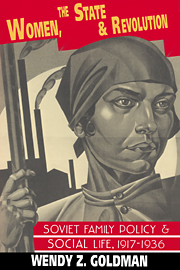Book contents
- Frontmatter
- Contents
- List of tables
- Acknowledgments
- 1 The origins of the Bolshevik vision: Love unfettered, women free
- 2 The first retreat: Besprizornost' and socialized child rearing
- 3 Law and life collide: Free union and the wage-earning population
- 4 Stirring the sea of peasant stagnation
- 5 Pruning the “bourgeois thicket”: Drafting a new Family Code
- 6 Sexual freedom or social chaos: The debate on the 1926 Code
- 7 Controlling reproduction: Women versus the state
- 8 Recasting the vision: The resurrection of the family
- Conclusion: Stalin's oxymorons: Socialist state, law, and family
- Index
- Soviet and East European Studies
8 - Recasting the vision: The resurrection of the family
Published online by Cambridge University Press: 26 March 2010
- Frontmatter
- Contents
- List of tables
- Acknowledgments
- 1 The origins of the Bolshevik vision: Love unfettered, women free
- 2 The first retreat: Besprizornost' and socialized child rearing
- 3 Law and life collide: Free union and the wage-earning population
- 4 Stirring the sea of peasant stagnation
- 5 Pruning the “bourgeois thicket”: Drafting a new Family Code
- 6 Sexual freedom or social chaos: The debate on the 1926 Code
- 7 Controlling reproduction: Women versus the state
- 8 Recasting the vision: The resurrection of the family
- Conclusion: Stalin's oxymorons: Socialist state, law, and family
- Index
- Soviet and East European Studies
Summary
What I eat and drink, how I sleep and dress is my private affair, and my private affair also is my intercourse with a person of the opposite sex.
August Bebel, 1879It is necessary to put an end to the anarchist view of marriage and childbirth as an exclusively private affair.
P. A. Krasikov, Deputy Chairman of the Supreme Court, 1936The prohibition on abortion in June 1936 was accompanied by a campaign to discredit and destroy the libertarian ideas that shaped social policy throughout the 1920s. After the ratification of the 1926 Family Code, the problems posed by divorce, alimony, family instability, and besprizornost' continued to mount. The process of forced collectivization created fresh streams of homeless, starving children, and rapid industrialization subjected the family to new and terrible strains. As women poured into the wage labor force at the end of the first Five Year Plan, the press drew increasing attention to a new phenomenon of “unsupervised and neglected” children (beznadzornos'). By 1935, the state had begun to crack down heavily on juvenile crime and the children of the streets. In 1936, jurists repudiated many of their earlier ideas, and in a clear ideological shift, demanded the strengthening and stabilization of the family. Couching the new policies in a populist appeal for social order, the Party aban-doned its earlier vision of social relations in favor of a new reliance on mass repression. The “withering-away” doctrine, once central to the socialist understanding of the family, law, and the state, was anathemized.
- Type
- Chapter
- Information
- Women, the State and RevolutionSoviet Family Policy and Social Life, 1917–1936, pp. 296 - 336Publisher: Cambridge University PressPrint publication year: 1993
- 2
- Cited by



